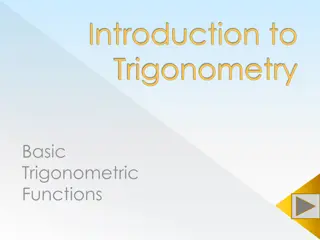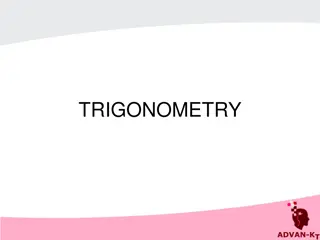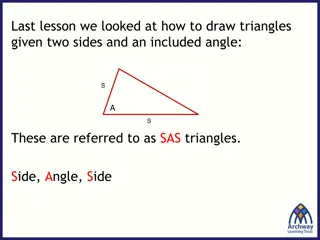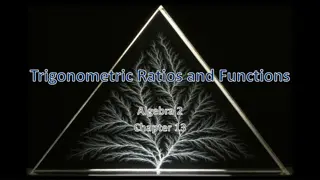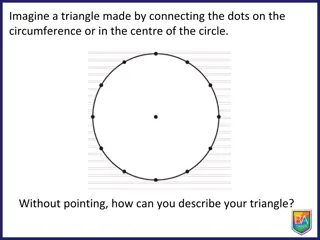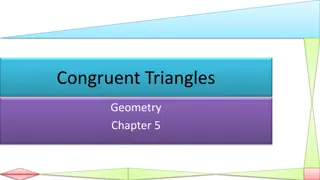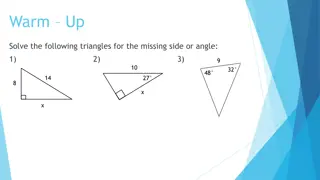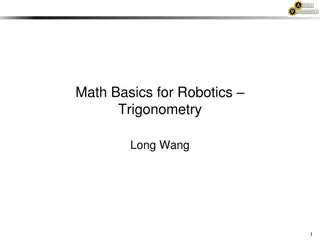
Perfect Squares and Pythagorean Theorem
Explore the concept of perfect squares and the practical application of the Pythagorean Theorem, which is fundamental for solving problems related to right triangles. Discover how to calculate square roots and find unknown lengths in right triangles using different formulas. Dive into the world of mathematics with visual examples and easy-to-follow explanations.
Download Presentation

Please find below an Image/Link to download the presentation.
The content on the website is provided AS IS for your information and personal use only. It may not be sold, licensed, or shared on other websites without obtaining consent from the author. If you encounter any issues during the download, it is possible that the publisher has removed the file from their server.
You are allowed to download the files provided on this website for personal or commercial use, subject to the condition that they are used lawfully. All files are the property of their respective owners.
The content on the website is provided AS IS for your information and personal use only. It may not be sold, licensed, or shared on other websites without obtaining consent from the author.
E N D
Presentation Transcript
A number that has a whole number as its square root is called a perfect square. The first few perfect squares are listed below. Slide 8.8- 2
Parallel Example 1Find the Square Root of Numbers Use a calculator to find each square root. Round answers to the nearest thousandth. 46 a. The calculator shows 6.782329983; round to 6.782 136 b. The calculator shows 11.66190379; round to 11.662 260 c. The calculator shows 16.1245155; round to 16.125 Slide 8.8- 3
Pythagorean Theorem (Gou Gou s Thm) Slide 8.8- 4
One place you will use square roots is when working with the Pythagorean Theorem. This theorem applies only to right triangles. Recall that a right triangle is a triangle that has one 90 angle. In a right triangle, the side opposite the right angle is called the hypotenuse. The other two sides are called legs. Slide 8.8- 5
?2+ ?2= ?2 Where a and b are legs and c is the hypotenuse. Slide 8.8- 6
Parallel Example 2Find the Unknown Length in Right Triangles Find the unknown length in each right triangle. Round answers to the nearest tenth if necessary. The unknown length is the side opposite the right angle. Use the formula for finding the hypotenuse. ( hypotenuse = leg a. 15 cm ) ( ) 2 2 + leg 8 cm ( ) 8 ( ) 15 2 2 + hypotenuse = + = 64 225 = 289 = 17 The length is 17 cm. long Slide 8.8- 8
Parallel Example 2 continued Find the Unknown Length in Right Triangles Find the unknown length in each right triangle. Round answers to the nearest tenth if necessary. Use the formula for finding the leg. b. 40 ft ( ( ) ( ) 2 2 leg = hypotenuse leg 15 ft ) ( ) 15 2 2 leg = 40 = 1600 225 = 1375 37.1 The length is approximately 37.1 ft long. Slide 8.8- 9
Parallel Example 3Using the Pythagorean Theorem An electrical pole is shown below. Find the length of the guy wire. Round your answer to the nearest tenth of a foot if necessary. ( ) ( ) 2 2 + hypotenuse = leg leg ( ) ( ) 60 ft 2 2 + hypotenuse = 35 60 35ft + = 1225 3600 = 4825 The length of the guy wire is approximately 69.5 ft. 69.5 Slide 8.8- 10
y Find the Distance between (-4,2) and (3,-7) ( ) ( ) 2 2 + x x y y 2 1 2 1 ( ) ( ) 2 2 + 3 4 7 2 x 49 81 + = 130 11.4
Example Find the distance between (4,-5) and (9,-2). Find the distance between (0,-2) and (-2,0) Find the distance between (-4,-6) and (2,5)
Hw Section 2.5 2-11


